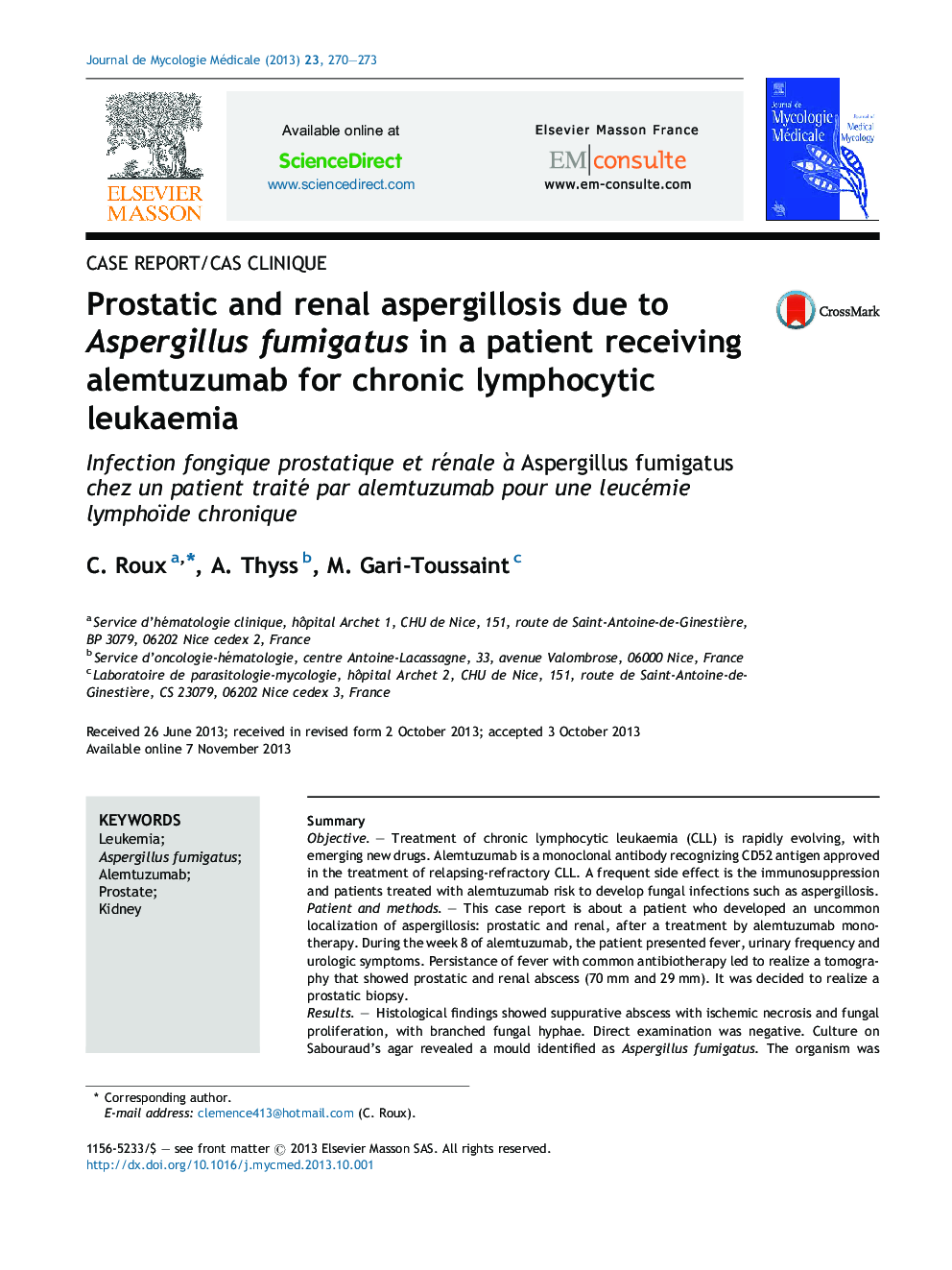| کد مقاله | کد نشریه | سال انتشار | مقاله انگلیسی | نسخه تمام متن |
|---|---|---|---|---|
| 3219440 | 1204447 | 2013 | 4 صفحه PDF | دانلود رایگان |

SummaryObjectiveTreatment of chronic lymphocytic leukaemia (CLL) is rapidly evolving, with emerging new drugs. Alemtuzumab is a monoclonal antibody recognizing CD52 antigen approved in the treatment of relapsing-refractory CLL. A frequent side effect is the immunosuppression and patients treated with alemtuzumab risk to develop fungal infections such as aspergillosis.Patient and methodsThis case report is about a patient who developed an uncommon localization of aspergillosis: prostatic and renal, after a treatment by alemtuzumab monotherapy. During the week 8 of alemtuzumab, the patient presented fever, urinary frequency and urologic symptoms. Persistance of fever with common antibiotherapy led to realize a tomography that showed prostatic and renal abscess (70 mm and 29 mm). It was decided to realize a prostatic biopsy.ResultsHistological findings showed suppurative abscess with ischemic necrosis and fungal proliferation, with branched fungal hyphae. Direct examination was negative. Culture on Sabouraud's agar revealed a mould identified as Aspergillus fumigatus. The organism was susceptible to voriconazole (MIC: voriconazole 0,25ug/mL).ConclusionBecause of the main side effect of alemtuzumab is immunosuppression, we have to research fungal infections such as Aspergillosis, particularly in patients with fever resistant to common antibiotherapy.
RésuméObjectifL’alemtuzumab est un anticorps monoclonal anti-CD52, indiqué dans le traitement des rechutes et des formes réfractaires de leucémie lymphoïde chronique. Un effet secondaire fréquent de cet anticorps est l’immunosuppression, et le risque de développer des infections fongiques, particulièrement à Aspergillus fumigatus.Patients et méthodesUn patient de 68 ans, traité par alemtuzumab a développé à la 8e semaine de traitement une aspergillose prostatique et rénale, accompagnée de fièvre et dysurie. Devant la persistance de la symptomatologie, il a été réalisé une tomodensitométrie thoraco-abdomino-pelvienne qui mettait en évidence un abcès prostatique de 70 mm associé à un abcès du rein droit de 29 mm. Il a été réalisé une biopsie prostatique.RésultatsL’examen anatomopathologique a mis en évidence un abcès suppuré avec des lésions ischémiques, nécrotiques, ainsi qu’une prolifération fongique évocatrice d’aspergillose, confirmée par la mise en culture sur milieu de Sabouraud qui a révélé la présence d’A. fumigatus sensible au voriconazole (CMI : 0.25 μg/mL).ConclusionParce qu’un effet secondaire fréquent de l’alemtuzumab est l’immunosuppression, il faut penser à prévenir et surveiller la survenue d’une infection aspergillaire, tout particulièrement chez des patients avec fièvre résistante à une antibiothérapie probabiliste.
Journal: Journal de Mycologie Médicale / Journal of Medical Mycology - Volume 23, Issue 4, December 2013, Pages 270–273